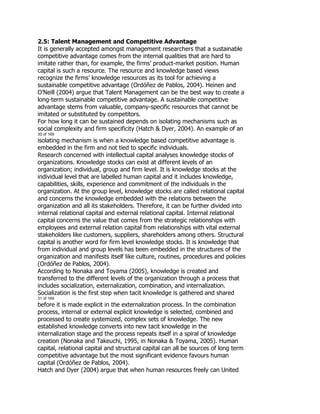
Talent management and competitive advantage
- 1. 2.5: Talent Management and Competitive Advantage It is generally accepted amongst management researchers that a sustainable competitive advantage comes from the internal qualities that are hard to imitate rather than, for example, the firms’ product-market position. Human capital is such a resource. The resource and knowledge based views recognize the firms’ knowledge resources as its tool for achieving a sustainable competitive advantage (Ordóñez de Pablos, 2004). Heinen and O’Neill (2004) argue that Talent Management can be the best way to create a long-term sustainable competitive advantage. A sustainable competitive advantage stems from valuable, company-specific resources that cannot be imitated or substituted by competitors. For how long it can be sustained depends on isolating mechanisms such as social complexity and firm specificity (Hatch & Dyer, 2004). An example of an 30 of 169 isolating mechanism is when a knowledge based competitive advantage is embedded in the firm and not tied to specific individuals. Research concerned with intellectual capital analyses knowledge stocks of organizations. Knowledge stocks can exist at different levels of an organization; individual, group and firm level. It is knowledge stocks at the individual level that are labelled human capital and it includes knowledge, capabilities, skills, experience and commitment of the individuals in the organization. At the group level, knowledge stocks are called relational capital and concerns the knowledge embedded with the relations between the organization and all its stakeholders. Therefore, it can be further divided into internal relational capital and external relational capital. Internal relational capital concerns the value that comes from the strategic relationships with employees and external relation capital from relationships with vital external stakeholders like customers, suppliers, shareholders among others. Structural capital is another word for firm level knowledge stocks. It is knowledge that from individual and group levels has been embedded in the structures of the organization and manifests itself like culture, routines, procedures and policies (Ordóñez de Pablos, 2004). According to Nonaka and Toyama (2005), knowledge is created and transferred to the different levels of the organization through a process that includes socialization, externalization, combination, and internalization. Socialization is the first step when tacit knowledge is gathered and shared 31 of 169 before it is made explicit in the externalization process. In the combination process, internal or external explicit knowledge is selected, combined and processed to create systemized, complex sets of knowledge. The new established knowledge converts into new tacit knowledge in the internalization stage and the process repeats itself in a spiral of knowledge creation (Nonaka and Takeuchi, 1995, in Nonaka & Toyama, 2005). Human capital, relational capital and structural capital can all be sources of long term competitive advantage but the most significant evidence favours human capital (Ordóñez de Pablos, 2004). Hatch and Dyer (2004) argue that when human resources freely can United
- 2. Kingdom UK organizations, the assumption can be made that competitive advantages that rely on human capital easily can disappear with the employees leaving. However, if human capital is newly acquired from another firm it needs to be adjusted and integrated into the new environment and only a part of its knowledge is instantly recognized. For individual knowledge to become a part of the firms’ competitive advantage it needs to be transferred and finally embedded in the entire organization (Ordóñez de Pablos, 2004). The time to tailor the human capital to its new environment and to find its best use is a cost and the result is not always that the knowledge can be wholly released in the new setting (Hatch & Dyer, 2004). A study of investment banks concluded that high performers rarely sustained their level of performance in a new organization (Deloitte, 2007b). This means that although human capital is the source of a competitive advantage it needs its system that it was originated from to be optimally valuable and 32 of 169 inimitable (Hatch & Dyer, 2004). This connects with Talent Management that needs to be firm specific to be most successful. It has to be customized to the organization’s business and human capital context (Heinen & O’Neill, 2004).
